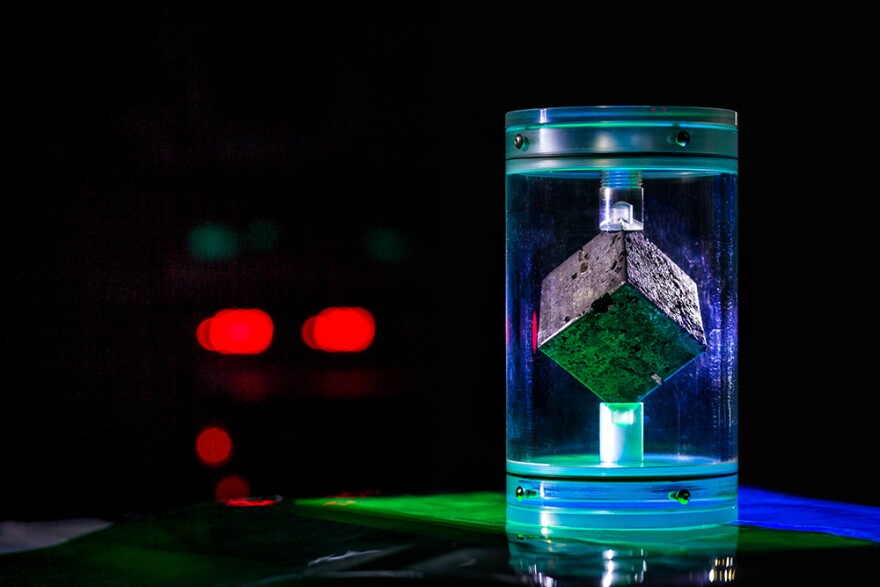Timothy Koeth's office is crammed with radioactive relics — old watches with glowing radium dials, pieces of melted glass from beneath the test of the world's first nuclear weapon.
But there is one artifact that stands apart from the rest: a dense, charcoal-black cube, 2 inches on a side. The cube is made of pure uranium metal. It was forged more than 70 years ago by the Nazis, and it tells the little-known story of Germany's nuclear efforts during World War II.
"From a historical perspective this cube weighs a lot more than 5 pounds," Koeth, a physicist at the University of Maryland, says as he holds it in his hand.
The cube entered Koeth's life on a hot August day in 2013. He was out for a jog when a friend called him on his phone.
"They said, 'I need to meet you as soon as possible,' " Koeth says.
Koeth told his friend to drive to a nearby parking lot. Twenty minutes later, he found himself staring at a small satchel in the trunk of the car. Inside, wrapped in paper towels was the cube.
"I looked at my friend and I said, 'Do you know what that is?' " Koeth recalls. "And my friend said, 'I think so, do you know what it is?' "
It turned out they didn't need to guess because wrapped around the cube was a piece of paper with the words, "Gift of Ninninger [sic], piece of uranium from the reactor Hitler tried to build."
At the time of Hitler's rise, Germany was actually at the cutting edge of nuclear technology. "Nuclear fission was discovered in Berlin in late 1938," says Alex Wellerstein, a historian of science at the Stevens Institute of Technology in Hoboken, N.J. "They were the first team of people who figured out how to split the atom, and figured out that when you split the atom, a lot of energy was going to be released."
That basic idea of splitting atoms to release energy is what's at the heart of all of today's nuclear power plants and all the world's nuclear weapons.

But back during World War II, it was all theoretical. To find out how it could work, the Germans devised strange looking experiment. Scientists strung together 664 cubes of uranium with aircraft cables and suspended them. The result looked "kind of like a very strange modernist chandelier of cubes," Wellerstein says.
The chandelier was dipped into a cylindrical tank of heavy water, which contains special isotopes of hydrogen that make it more conducive to nuclear reactions.
The setup was known as the B-VIII reactor. The Germans were experimenting with it inside a cave in the southern town of Haigerloch. They were still trying to get it to work when the Allied invasion began. As Allied forces approached, the German scientists disassembled the reactor and buried the cubes in a field.
The first wave of Allied troops to arrive included a task force known as Alsos, which was seeking to seize as much of the Nazi program as they could.
The Nazi scientists quickly disclosed the location of the buried cubes to the Allies, Wellerstein says. The Alsos team boxed up the cubes, to send them back to America, but what happened after that is not entirely clear.
"The records on this kind of stuff are less good than you might expect, given what they are," Wellerstein says.
The news that the U.S. government has misplaced over 600 cubes of Nazi uranium might seem highly alarming. However, the cubes are made of natural uranium, which is not particularly radioactive or valuable.
And Wellerstein points out that the Nazi program never even got close to building a bomb. It's really a footnote in the history books.
But Timothy Koeth doesn't see it as a footnote. At the start of the war, the Americans thought the Nazis were racing toward a bomb, and that's a big part of why they rushed ahead with the Manhattan Project to build the world's first nuclear weapon.
From a historical perspective this cube weighs a lot more than 5 pounds.
As Koeth sees it, it was the fear of the little black cubes like the one on his desk that launched the nuclear age.
"Nuclear weapons, nuclear power, the Cold War, this nuclear hostage that the planet is held in — it's all motivated by this effort that produced just these 600-and-some cubes," Koeth says.
Which is why Koeth is determined to find out what happened to them. Starting with the one from the trunk of the car. And a big clue was in that note wrapped around the cube.
"Literally just a few weeks later I was at a flea market and was looking through a box of science books and came across this book called Minerals for Atomic Energy by Robert D. Nininger," Koeth says.
It turns out Robert Nininger was in charge of inventory for part of the Manhattan Project. It's likely that he oversaw the arrival of the Nazi cubes from Europe. Miriam Hiebert, a post-doctoral researcher working with Koeth, says it's possible Nininger or one of his colleagues handed out a few cubes as souvenirs.
"It sounds nuts to us, but physicists back in the 1940s, it wouldn't have been quite as alarming," she says with a laugh.
Koeth and Hiebert were able to verify that Nininger did have a cube, which he kept in his possession until he died. It was found in his estate, and passed to Koeth's friend, who gave it to him.

In fact, there are a few other cubes out there. One was donated to Harvard by a physicist who worked on the original Alsos mission to recover the uranium. The Smithsonian has one that was found in the back of a drawer in New Jersey. And another one in Germany was recovered from a creek. It was reportedly tossed away by the famous physicist Werner Heisenberg, as he fled ahead of the approaching Allied forces.
There are still around 650 cubes completely unaccounted for. It's possible that many were fed into the U.S. government's nuclear complex after the war and eventually manufactured into American atomic weapons.
But Hiebert and Koeth believe that many, perhaps most, of the cubes survived.
"It genuinely would not shock me at all if they're sitting in a box somewhere and nobody has wanted to move this really heavy box for the past 70 years," Hiebert says. She and Koeth are hoping someone will stumble across the missing uranium and give them a call.
Read more about the cubes in Physics Today.
Copyright 2021 NPR. To see more, visit https://www.npr.org.



